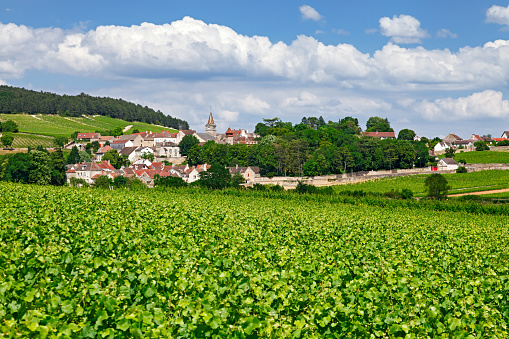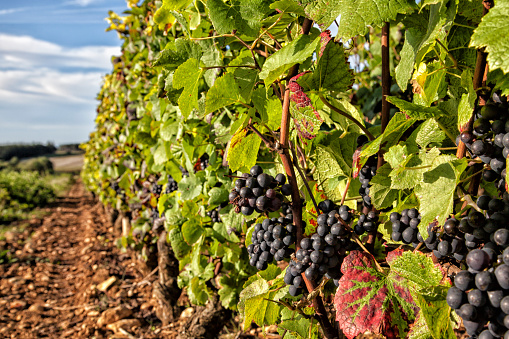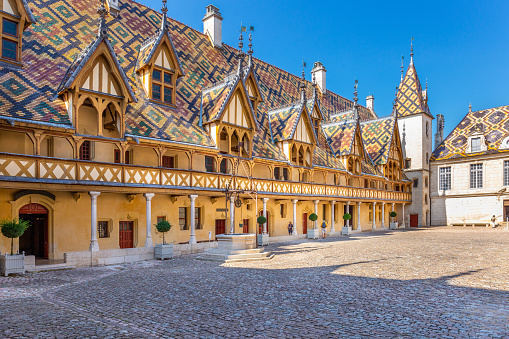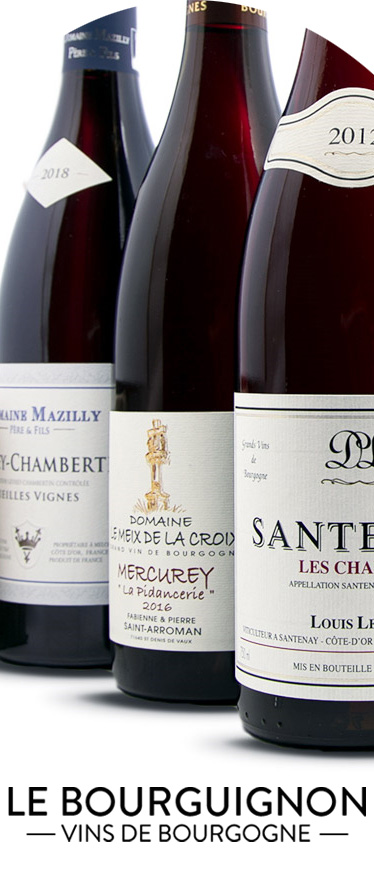The Côte de Beaune renowned throughout the world for its great dry white wines , its great wines of great renown such as Montrachet, Bienvenues-Bâtard-Montrachet,… to be enjoyed once in a lifetime!
The history of the Côte de Beaune
The Côte de Beaune consists of vineyards that extend from the commune of Ladoix-Serrigny and ends at Cheilly les Maranges (geographically dominated by the Hautes-Côtes de Beaune) in the Department of Côte d'Or.
The landscapes of the Côte de Beaune are magnificent, there are white grape vines, red grape vines, gentle slopes, where upscale villages and modest villages alternate.
🇫🇷 The vineyards of the Côte de Beaune, one of the five great vineyards of Burgundy, are under the sun! ☀️📷Richard Semik / 123RF #MondayMotivation #MondayMorning #Monday #sun #soleil #cotedebeaune #soleil #vignoble #bourgogne #France #terroir #tourisme #decouverte #voyage #travel pic.twitter.com/p4Bmt0Orxx
— The Good Guide (@lebonguidefr) May 27, 2019
It is one of the five great vineyards of Burgundy :
- Chablis and the Grand Auxerrois
- the Côte de Nuits, the Hautes Côtes de Nuits and the Châtillonnais
- the Côte de Beaune and the Hautes Côtes de Beaune
- the Côte Chalonnaise and the Couchois
- the Mâconnais
From the fourteenth century, the Benedictines, the Carthusians, the monks of Cîteaux and Cluny, not to mention the Dukes of Burgundy put forward the wines and "climates" of the Côte de Beaune and since then they still have an excellent reputation.
|
The term "climate" refers to plots of land in Burgundy. This word takes into account the know-how of the winegrowers, the geological characteristics, the particular exposures where each plot is precisely delimited. |
Incredible the Côte de Beaune shines internationally for its great white wines such as Corton-Charlemagne, Meursault … and the famous Montrachet, one of the greatest white wines in the world!
Beaune, the current capital of Burgundy wine
We can talk about Beaune as the capital of wines, it is an extremely dynamic territory. First, the great historical trading houses such as Bouchard, Champy, Drouhin, Jadot,… are located in Beaune. Then because the wine institutions of the Coast (interprofession and traders' union) are very represented. Not to mention of course the Hospices de Beaune, a heritage full of a prestigious history.
Trading in Burgundy
At the time, the winemaker was in the vineyard and in the press, the merchant in the barrels and it was up to him to take care of the ageing of the wine. It is in the eighteenth century that a large part of the trading houses settled there, a particularity of Burgundy the trade-breeder.
To begin with, the winegrowers take care of the work of the vine (pruning, maintenance,…), the harvest, the first stages of vinification (fermentation, pressing and funneling), it is then that the merchant intervenes by bringing the barrels and then raising the wine as he wishes in his cellars.
The trader-breeder has a technical know-how, through his work he brings an added value and plays an essential role in the quality of the finished product.
The advantages of this method are numerous:
- for the winemaker this makes it possible not to worry about vinifications that can be risky and uncertain
- as for the trader-breeder, he earns money by raising his cuvées at the request of his customers
Since the crisis of the 1980s (the oil shock of 1973), the number of traders has greatly decreased, which is why currently there are only 60 trading houses located in Burgundy.Nowadays, winemakers prefer to breed and market their wines themselves.
The Côte de Beaune vineyard produces high-class white wines, all in elegance and finesse as well as prestigious red wines.
The different appellations of the Côte de Beaune (from north to south):
Ladoix-Serrigny
This town offers supple and delicate wines, the soil is predominantly limestone-marl, a little clay in the sectors that produce white wines.
Aloxe-Corton
This village produces wines of great power, supple and delicate. A clay-limestone predominantly soil , very stony in places.
Corton
The hill of Corton offers grands crus in both colors, wines of legendary generosity, with a production of around 3,500 hectoliters. Corton is the most important grand cru of Burgundy and the only grand cru in red of the Côte de Beaune, it is subdivided into about twenty climates (Le Clos du Roi, Le Corton, Les Bressandes, Les Perrières, Les Renardes,…).
It is essentially composed of brown soil composed of black rendzines born of scree and limestone reddened by oolithe.
Corton-Charlemagne
Corton-Charlemagne, the highest, covers the mountain of Corton. Soft wines, with notes of sweet spices (cinnamon,…) and salty spices (cloves,…) which bloom on a soil of white marls.
Pernand-Vergelesses
Supple and delicate wines, part of which Corton-Charlemagne is located in this town that produces red Corton with a predominantly clay-limestone terroir.
Savigny
A lot of finesse, tender wines. A geology of great diversity but predominantly clay-ferruginous and limestone.
Chorey
Excellent wines but no first growths on this appellation, varied soils between limestone with a little iron to the west, sand, stones to the north and finally marl-gravel to the south.
Beaune
Since the eighteenth century, it is in Beaune that the powerful business bourgeoisie has settled, at the same time the wine of Beaune becomes a generous red wine, full-bodied, guard with many bodies.
Excellent wines , very good qualities unfortunately no premier crus on this appellation. A soil composed of limestone mixed with sand or clay in places.
The red wines of the Côte de Beaune are exceptional wines like Pommard, Volnay, Corton and many others…
Pommard
Known since the Middle Ages for its firm, colorful, powerful and finely aging red wines, no white wine production on this appellation. Too bad… no grands crus for this appellation but first growths of good reputation (Clos Blanc, Clos de la Commaraine, Clos de Verger, Les Rugiens-Bas, Les Saussilles,…). Calcareous and clayey soils.
Panorama of the beautiful vineyards of Pommard where the bunches 🍇 bask under the 🌞 #Vineyards #cetetejevisitelafrance https://t.co/mOixV6vNtg
— Beaune Tourisme (@BeauneTourisme) July 27, 2020
Volnay
This appellation also offers only red wine, with a lot of elegance, lightness and among the most tender of the Côte de Beaune. No grand cru on this appellation but many first growths (Champans, Clos de Cave des Ducs, Les Caillerets,…). A terroir composed of limestone marls and clay-limestone scree. Small less famous villages also offer beautiful discoveries with excellent value for money such as Monthélie, Auxey-Duresses, Saint-Aubin, Saint-Romain, Santenay, les Maranges. To know without further delay …
Monthélie
A very pleasant bouquet, notes of fruit, to discover without further delay. Mostly calcareous and clayey soils for some climates.
Auxey-Duresses
White wines of a beautiful roundness, with fat and in the finish a lemon acidity. For red wines, fruity, fleshy and peppery notes on the palate. This appellation of origin has nine premier crus (Climat du Val, Clos du Val, Les Bréterins, La Chapelle, Reugne, Les Duresses, Bas des Duresses, Les Grands Champs, Les Écusseaux). A terroir composed of limestone and marl for white wines, limestone and clay for red wines.
Saint-Romain
Well known for its white wines, this appellation offers sweet, lively and mineral wines. Its terroir is favorable, consisting of limestone marls with clay banks.
Meursault
Wines with aromas of dried fruit (hazelnut,…), white fruit (ripe bunch of white grapes,…), dry and supple palate. The grape variety used for its white wines ( Chardonnay) is in its favorite terrain, composed of white marls. In the northern part a limestone, gravel and clay soil , suitable for red wines.
Wines produced on the Santenots climate are entitled to the AOC Meursault for white wines and Volnay for red wines.
=> Blagny
Exception for this one: only the red wines of this hamlet can claim the AOC Blagny. Depending on their geographical location, whites benefit from AOC Meursault or Puligny-Montrachet 1er cru.
After Meursault and up to Chassagne-Montrachet, the Barthonian floor and the Comblanchien limestone take their place. The marls are interspersed in the limestone to offer Chardonnay the clay soils that suit it better than a rocky soil.
Puligny and Chassagne spread the hill of Montrachet, dedicated to Chardonnay through four great vintages, the most famous of which is Montrachet.
Puligny-Montrachet
The Puligny-Montrachet appellation offers largely white wines (95.92 hectares of production) and very few red wines (0.36 hectares of production).
Fruity and distinguished white wines, it is the temple of the great white wines:
- Montrachet (considered one of the best white wines in the world)
- Bastard-Montrachet
- Chevalier-Montrachet
- Bienvenues-Bâtard-Montrachet
The red wines of Puligny-Montrachet have body and finesse.
Soils rich in pebbles and clay-limestone.
Chassagne-Montrachet
This appellation offers opulent white wines and tannic reds.
Three grands crus in whites of great class:
- Montrachet
- Bastard-Montrachet
- Criots-Bâtard-Montrachet
Wines of very good reputation, possibility to keep them several years in the cellar, very good hold. White wines are produced on clayey brown limestone and red wines on marl limestone.
AOC wines produced on Puligny and Chassagne are sought after all over the world.
Saint-Aubin
Tense, mineral and elegant whites while the red wines are light but of great delicacy.
For white wines, a soil consisting of white earth with clay. For red wines of limestone with pebbles.
Wines of very good quality even if many do not know since it suffers from the fame of its close neighbors.
Santenay
Mostly red wine for this appellation, red Santenay is appreciated for its fleshy side, its delicate tannins, very pleasant to drink in youth. The white Santenay reveals an expressive and pleasant bouquet, aromas of dried fruits (hazelnut,…) and vegetable (fern,…).The vines are planted on hard limestone with marls.
Maranges
Since 1989, this controlled designation of origin has replaced the following AOCs:
- Cheilly
- Dezize
- Sampigny
The communal appellation of the Côte de Beaune there more southern on a clay-limestone liasic soil.
🍇🐌🏘️ The Maranges are the southernmost communal appellation of the Côte de Beaune. Beyond the Mont de Sène, a unique hilly landscape with a multiple orientation emerges. It is this unique terroir, politically in Saône-et-Loire, wine-growing in Côte-d'Or 😍🙈 pic.twitter.com/4bIqXGHGN0
— Bourgogne-du-Sud Stan Account 🐰🐌 (@HT_Glt) October 30, 2020
Côte de Beaune-Villages
Produced only red wine, each winegrower can choose either the communal AOC or the Côte de Beaune-Villages AOC. The nature of the soil is varied due to the large extent of the appellation, mainly clay-limestone.
Côte de Beaune
It is a small AOC , it does not apply to the entire Côte de Beaune.
Burgundy Hautes-Côtes de Beaune
The vineyards of the Hautes-Côtes de Beaune produce excellent Burgundy from regional appellations that can also benefit from the Burgundy Hautes-Côtes de Beaune appellation.
The Grands Crus are concentrated on two hills : that of Corton dedicated to the reds and that of Montrachet dedicated to the whites.
Finally few grands crus in Côte de Beaune since at the time the merchants-breeders preferred to value only the name of the village and especially their own brand.
Grape varieties
- The Chardonnay used for all the white wines of the Côte de Beaune, is popular on the marly soils quite clayey. This grape variety offers wines with aromas of dried fruits (hazelnut,…), confectionery (honey,…), empyreumatic (toast,…), it is an explosion of flavors of incredible richness. Dry, fatty wines, well balanced between acidity and softness and of remarkable persistence. Very long guarding capacities, from 10 to 20 years and much more for the biggest names.
The prestigious white Burgundies can be enjoyed with fine fish, crustaceans in sauce, white meats, why not foie gras and for lovers of powerful cheeses such as epoisses, blues,… it will marry very well.
- Pinot Noir is particularly popular in the Côte de Beaune on the limestone soils of hillsides, well drained, and in temperate climates hence its great fame. This black grape variety gives birth to wines of very different characters depending on the terroir. It reveals a very expressive nose with an incredible bouquet, notes of red fruits (cherry, strawberry, raspberry,…), black fruits (blackcurrant, blackberry,…), flowers (peony, violet,…), undergrowth (mushroom,…), dry (hay,…), empyreumatic (hay,…), jammed (wild strawberry, kirsch,…). On the palate, a beautiful power, firm wines and tannins of a beautiful finesse.
- Pinot Beurot is a white grape variety very little widespread in Burgundy (2% of the vineyards of the Côte de Beaune), it can be used during the elaboration of red wines, this will bring it fat.
At the time of service, it is advisable to serve white wines between 12 to 14 ° C and red wines between 15 to 16 ° C for the older ones, and for young red wines serve them fresher.
***
Our own lighthouse that has saved so many people to this day. The place has become a museum where the soulmates of Nicolas and Guigone still walk around and continue to watch over the health of the Beaunois. @hospicescivils https://t.co/p04TYdogKj https://t.co/5yM6eI88Nf
— Beaune Tourism (@BeauneTourisme) August 5, 2020
Who has never heard of the famous wine sale of the Hospices de Beaune?
The creation of the Hospices, also called the Hôtel-Dieu was created in 1443 by Nicolas Rollin (Chancellor of the Duke of Burgundy) and his wife Guigogne de Salins. For five centuries it was a hospital that allowed to treat many patients (surgery, maternity, medicine, pediatrics, intensive care, emergencies,…).
Nowadays due to the influx of visitors, patients are hospitalized in another building. It has become a historical monument as well as a prestigious winery composed of a set of vineyards of the best appellations of Burgundy (an area of 61 hectares), constituted over the centuries thanks to legacies and donations.
=> Their production is marketed every year at the big auction.
This sale can be considered the largest charity sale in the world, in 2000 the amount of the sale amounted to 3,771,193 euros. In addition, it plays an important role for tourism in Beaune and its region.
It was in 1859 that it all began …Joseph Pétasse (the bursar of the Hospices) organizes the Three Glorious Ones, this event lasts three days:
- on Saturday takes place the tasting of the wines of the year, the dozens of barrels of the production of the vines of the Hospices are tasted by hundreds of brokers and traders, this allows them to give their opinion to the buyers. And in the evening is held the chapter of the Knights of Tastevin at the Clos de Vougeot.
The big day has arrived, the halls of Beaune are full of people, many Burgundy merchants have come to buy even if three-quarters of the orders were placed as soon as the harvest was made.
- on Sunday afternoon, the auction starts, the public looks through the glass and observes the minimalist ballet of the principals raising their plate with their fingertips. In the past, this sale took place "by candlelight"; now, it is a hammer blow that resonates!
- on Monday, the ceremonies end with the paulée de Meursault (the end-of-harvest meal).




